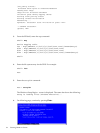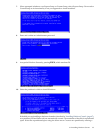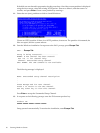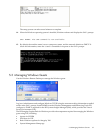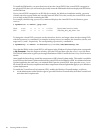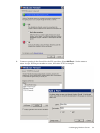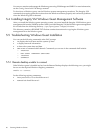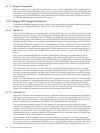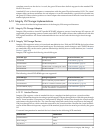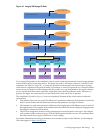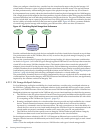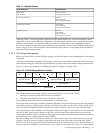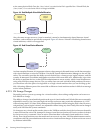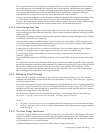6.1.1.5 Storage Configurability
VM Host administrators expect the virtual machines to be as easily configurable as HP Integrity servers.
The Integrity VM storage subsystem allows for easy changes of the storage devices through Integrity VM
commands. Using these commands, the VM Host administrator dynamically adds, deletes, and modifies
storage devices on virtual machines. Guest administrators can change some storage, limited in scope by
the VM Host administrator, using the virtual console.
6.1.2 Integrity VM Storage Architectures
Toprovide the flexibilityrequired to meet a varietyof data center needs, theIntegrity VM storage subsystem
consists of two storage architectures: “Shared I/O” and “Attached I/O” (page 62).
6.1.2.1 Shared I/O
The shared I/O architecture is a means by which a virtual machine accesses an entirely virtualized storage
subsystem provided by Integrity VM. The Integrity VM storage subsystem emulates real hardware to the
virtual machine while interacting with the VM Host to complete the virtual machine I/O operation to the
VM Host storage entity. This abstraction provides the ability of a VM Host administrator to share physical
VM Host storagehardware across multiplevirtual machines and to allocatethat storage at sub-LUN levels.
The sharing of individual storage LUNs is accomplished by dividing a VM Host LUN into smaller parts,
like hard disk partitions, logical volumes, or files. Each of these sub-LUN VM Host entities can then be
used as media for separate virtual storage devices. Virtual machines access the virtual storage devices as
real storage devices, with no knowledge that the virtual storage media is actually a sub-LUN VM Host
entity.
The way the virtual storage media is accessed by the Integrity VM storage subsystem allows virtual
machines to share physical VM Host storage adapters. All virtual storage media is accessed through
user-defined interfaces onthe VM Host. TheVM Host maintains complete controlof the physical hardware
and handles the virtual machine I/O operations just as it would be handled for any other user application.
Thus, just as hardware is shared among normal applications running on the VM Host, virtual machine
I/O is shared across the physical storage as well.
This architecture also provides for whole LUNs to be virtualized. While this does not increase storage
utilization, it does provide higher storage availability. Because the LUN is virtualized, the guest OS does
not have to support the physical VM Host LUN. It only has to be able to support the virtualized version
of it. Thus by using shared I/O, a virtual machine can run with any physical hardware that is supported
by the VM Host.
Finally, all virtual machine I/O requests in shared IO are processed by virtual adapters. A virtual adapter
is either an emulation of a real adapter that a native guest OS driver accesses as real hardware, or a special
driver loaded into the guest OS. In either case, the virtual adapter uses internal Integrity VM storage
subsystem calls to handle communication of virtual machine I/O to the virtual devices. This connection
between the virtual adapter and the virtual devices need not resemble anything in an HP Integrity server
system. It is emulated so that the virtual machine does not know the difference.
6.1.2.2 Attached I/O
Attached I/O allowsa virtual machine toaccess to a VM HostLUN directly. In thisarchitecture, the Integrity
VM storage subsystem attaches a LUN on the VM Host to a virtualized storage adapter. A LUN can be a
disk, DVD, tape, media changer, or other peripheral device types. Because attached I/O does not require
device virtualization, the performance of attached I/O might be better than shared I/O.
The main difference between shared I/O and attached I/O is the degree to which a physical storage
subsystem is virtualized. In shared I/O, an entire storage subsystem is virtualized. Therefore, all physical
adapters on the VM Host and all the storage connected to those adapters may be shared among virtual
machines. In attached I/O, only the storage adapter is virtualized. Therefore, only the VM Host physical
storage adapters may be shared. At least one LUN, the attached LUN, cannot be shared. It is owned and
solely controlled by the virtual machine it is attached to.
To provide the VM with complete control over attached devices, the Integrity VM storage subsystem
interprets I/O requests from the guest device drivers into I/O requests that can be completed by the VM
Host storage subsystem on the guest's behalf. In the process, the VM Host storage subsystem sends all the
actual data and responses back the guest device drivers. With all this data, the guest device driver is in
62 Creating Virtual Storage Devices



